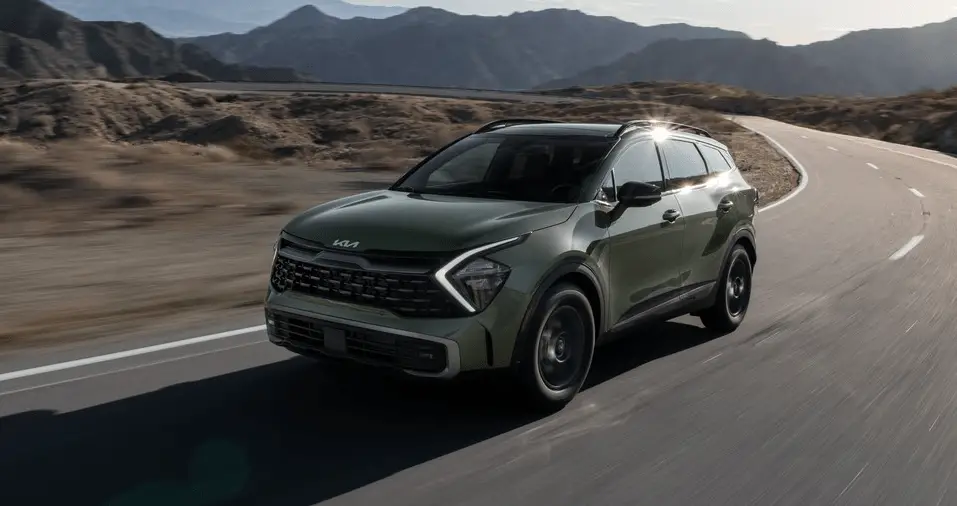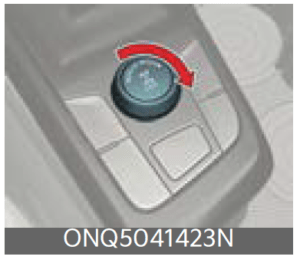Kia Sportage 2023 Automatic Transmission (Shift Lever) and All Wheel Drive System
The Kia Sportage 2023 is a compact SUV that boasts a wide range of advanced features to enhance the driving experience. Two notable features of this vehicle are its automatic transmission (shift lever) and all-wheel-drive (AWD) system. The automatic transmission of the Sportage 2023 is designed to deliver a seamless and efficient driving experience. The shift lever is conveniently located on the center console for easy access and includes a sequential shift mode for drivers who prefer a more engaging driving experience. Additionally, the transmission has a Sport mode that optimizes the shift points to provide a more responsive driving experience. The all-wheel-drive system of the Sportage 2023 is engineered to provide superior traction and control across various driving conditions. The system continually monitors the driving conditions and adjusts torque distribution between the front and rear wheels to optimize handling and traction. Furthermore, the AWD system features a locking centre differential that can be activated at low speeds to maximize traction in challenging conditions. Overall, the automatic transmission and all-wheel-drive system in the Kia Sportage 2023 deliver a comfortable and confident driving experience in various road and weather conditions.
2023 KIA SPORTAGE Specs, Price, Features and Mileage (Brochure)
Automatic transmission (Shift Lever)
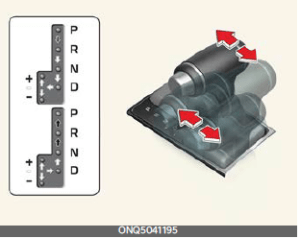
- Depress the brake pedal and the unlock button when shifting.
- Press the unlock button when shifting.
- The shift lever can be shifted freely.
Automatic transmission operation
The automatic transmission has 8 forward speeds and one reverse speed. The individual speeds are selected automatically, depending on the balance between the fuel economy and the power.
NOTICE
The first few shifts on a new vehicle, if the battery has been disconnected, may be somewhat abrupt. This is a normal condition, and the shifting sequence will adjust after shifts are cycled a few times by the TCM (Transmission Control Module) or PCM (Powertrain Control Module).
For smooth operation, depress the brake pedal when shifting from N (Neutral) to a forward or reverse gear.
WARNING
Automatic transmission
- Always check the surrounding areas near your vehicle for people, especially children, before shifting a vehicle into D (Drive) or R (Reverse).
- Before leaving the driver’s seat, always make sure the shift lever is in the P (Park) position; then set the parking brake fully and shut the engine off. Shifting into P (Park) while the vehicle pecked and sudden vehicle movement can occur if these precautions are not followed in the order identified.
- Do not use the engine brake (shifting from a high gear to lower gear) rapidly on slippery roads.
The vehicle may slip causing an accident.
CAUTION
- To avoid damage to your transmission, do not accelerate the engine in R (Reverse) or any forward gear position with the brakes on.
- When stopped on an incline, do not hold the vehicle stationary with engine power. Use the service brake or the parking brake.
- Do not shift from N (Neutral) or P (Park) into D (Drive), or R (Reverse) when the engine is above idle speed.
Transmission ranges
The indicator in the instrument cluster displays the shift lever position when the ignition switch or ENGINE START/STOP button is in the ON position.
P (Park)
Always come to a complete stop before shifting into P (Park). This position locks the transmission and prevents the front wheels from rotating.
WARNING
- Shifting into P (Park) while the vehicle is in motion will cause the drive wheels to lock which will cause you to lose control of the vehicle.
- Do not use the P (Park) position in place of the parking brake. Always make sure the shift lever is latched in the P (Park) position and set the parking brake fully.
- Never leave a child unattended in a vehicle.
CAUTION
The transmission may be damaged if you shift into P (Park) while the vehicle is in motion.
R (Reverse)
Use this position to drive the vehicle backwards.
N (Neutral)
The wheels and transmission are not engaged. The vehicle will roll freely even on the slightest incline unless the park-ing brake or service brakes are applied.
WARNING
Do not drive with the shift lever in N (Neutral).
The engine brake will not work and lead to an accident.
CAUTION
- Always park the vehicle in “P” (Park) for safety and engage the parking brake. If left in “N” (Neutral), the vehicle may move and cause serious damage and injury.
- After the ignition switch or ENGINE START/STOP button has been turned off, the electronic parking brake cannot be disengaged.
- For EPB (Electronic Parking Brake) equipped vehicles with AUTO HOLD function used while driving, if the ignition button has been turned “OFF”, the electronic parking brake will be engaged automatically. Therefore, AUTO HOLD function should be turned off before the ignition button is turned off.
D (Drive)
This is the normal forward driving position. The transmission will automatically shift through 8 gear sequence, providing the best fuel economy and power.
For extra power when passing another vehicle or climbing grades, depress the accelerator fully, at which time the transmission will automatically downshift to the next lower gear.
NOTICE
Always come to a complete stop before shifting into D (Drive).
Manual mode
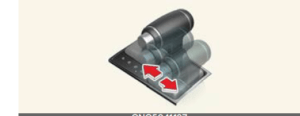
Whether the vehicle is stationary or in motion, manual mode is selected by pushing the shift lever from the D (Drive) position into the manual gate. To return to D (Drive) range operation, push the shift lever back into the main gate.
In manual mode, moving the shift lever backwards and forwards will allow you to make gearshifts rapidly. In contrast to a manual transmission, manual mode allows gearshifts with the accelerator pedal depressed.
- Up (+): Push the lever forward once to shift up one gear.
- Down (-): Pull the lever backwards once to shift down one gear.
NOTICE
- The driver must execute upshifts in accordance with road conditions, taking care to keep the engine speed below the red zone.
- Only the 8 forward gears can be selected. To reverse or park the vehicle, move the shift lever to the R (Reverse) or P (Park) position as required.
- Downshifts are made automatically when the vehicle slows down. When the vehicle stops, 1st gear is automatically selected.
- When the engine rpm approaches the red zone shift points are varied to upshift automatically.
- To maintain the required levels of vehicle performance and safety, the system may not execute certain gear shifts when the shift lever is operated.
- When driving on a slippery road, push the shift lever forward into the +(up) position. This causes the transmission to shift into the 2nd gear which is better for smooth driving on a slippery road. Push the shift lever to the (down) side to shift back to the 1st gear.
Paddle shifter (if equipped)
The paddle shift function is available when the shift lever is in the D (Drive) position or the manual mode.

With the shift lever in the D position
Pull the [+] or [-] paddle shifter once to shift up or down one gear and the system changes from automatic mode to manual mode.
Paddle shifter doesn’t work at low vehicle speed.
To change back to automatic shift mode from manual shift mode, do one of the following:
- Pull the [+] paddle shifter for more than one second
- Move the shift lever from D (Drive) to the manual gate and return it to D position again
The manual shift mode also changes back to automatic shift mode in one of the following situations
When the accelerator pedal is gently depressed for more than 6 seconds while driving When the vehicle stops
With the shift lever in the manual mode
Pull the [+] or [-] paddle shifter once to shift up or down one gear.
NOTICE
If you pull the [+] and [-] paddle shifters at the same time, you cannot shift the gear.
Shift lock system
For your safety, the automatic transmission has a shift lock system which prevents shifting the transmission from P (Park) into R (Reverse) unless the brake pedal is depressed.
To shift the transmission from P (Park) into R (Reverse):
- Depress and hold the brake pedal.
- Start the engine or turn the ignition switch or ENGINE START/STOP button to the ON position.
- Move the shift lever.
If the brake pedal is repeatedly depressed and released with the shift lever in the P (Park) position, a chattering noise near the shift lever may be heard. This is a normal condition.
WARNING
Always fully depress the brake pedal before and while shifting out of the P (Park) position into another position to avoid inadvertent motion of the vehicle which could injure persons in or around the vehicle.
Shift-lock override
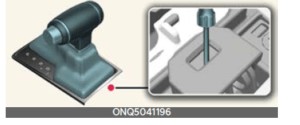
If the shift lever cannot be moved from the P (Park) position into R (Reverse) position with the brake pedal depressed, continue depressing the brake, then do the following:
- Place the ignition switch or ENGINE START/STOP button in the LOCK/OFF position.
- Apply the parking brake.
- Carefully remove the knob boots covering the shift-lock release access hole.
- Insert a tool (e.g., flathead screw-driver) into the access hole and press down on the tool.
- Move the shift lever.
- Remove the tool from the shift-lock override access hole then install the knob boots.
- If the shift lever does not move even after performing this procedure, have the system inspected by an authorized Kia dealer.
Good driving practices
- Never move the shift lever from P (Park) or N (Neutral) to any other position with the accelerator pedal depressed.
- Never move the shift lever into P (Park) when the vehicle is in motion.
- Be sure the vehicle is completely stopped before you attempt to shift into R (Reverse) or D (Drive).
- Never take the vehicle out of gear and coast down a hill. This may be extremely hazardous. Always leave the vehicle in gear when moving.
- Do not “ride” the brakes. This can cause them to overheat and malfunction. Instead, when you are driving down a long hill, slow down and shift to a lower gear. When you do this, engine braking will help slow down the vehicle.
- Slow down before shifting to a lower gear. Otherwise, the lower gear may not be engaged.
- Always use the parking brake. Do not depend on placing the transmission in P (Park) to keep the vehicle from moving.
- Exercise extreme caution when driving on a slippery surface. Be especially careful when braking, accelerating or shifting gears. On a slippery surface, an abrupt change in vehicle speed can cause the drive wheels to lose traction and the vehicle to go out of control.
- Optimum vehicle performance and economy is obtained by smoothly depressing and releasing the accelerator pedal.
WARNING
- When driving uphill or downhill, always shift to D (Drive) for driving forward or shift to R (Reverse) for driving backwards, and check the gear position indicated on the cluster before driving. Driving in the opposite direction of the selected gear can lead to a dangerous situation by shutting off the engine and affecting the braking performance.
- Always buckle-up! In a collision, an unbelted occupant is significantly more likely to be seriously injured or killed than a properly belted occupant.
- Avoid high speeds when cornering or turning.
- Do not make quick steering wheel movements, such as sharp lane changes or fast, sharp turns.
- The risk of a rollover is greatly increased if you lose control of your vehicle at highway speeds.
- Losing control often occurs if two or more wheels drop off the roadway and the driver oversteers to reenter the roadway.
- In the event your vehicle leaves the roadway, do not steer sharply. Instead, slow down before pulling back into the travel lanes.
- Never exceed posted speed limits.
WARNING
If your vehicle becomes stuck in snow, mud, sand, etc., then you may attempt to rock the vehicle free by moving it for-ward and backwards. Do not attempt this procedure if people or objects are anywhere near the vehicle. During the rock-ing operation, the vehicle may suddenly move forward or backwards as it becomes unstuck, causing injury or damage to nearby people or objects.
Moving up a steep grade from a standing start
To move up a steep grade from a standing start:.
- Depress the brake pedal, and shift the shift lever to D (Drive).
Select the appropriate gear depending on load weight and steepness of the grade, and release the parking brake. Depress the accelerator gradually after releasing the service brakes.
All Wheel Drive (AWD) system (if equipped)
The All Wheel Drive (AWD) system delivers engine power to front and rear wheels for maximum traction.
AWD is useful when extra traction is required, such as when driving slippery, muddy, wet, or snow-covered roads.
If the system determines there is a need for four wheel drive, the engine’s driving power will be distributed to all four wheels automatically.
WARNING
Off-road driving
This vehicle is designed primarily for on-road use although it can operate effectively off-road. However, it was not designed to drive in challenging off-road conditions. Driving in conditions that exceed the vehicle’s intended design or the driver’s experience level may result in severe injury or death.
NOTICE
If the AWD warning light ( ) stays on the instrument cluster, your vehicle may have a malfunction with the AWD system. When the AWD warning light ( )
appears, to have your vehicle checked by an authorized Kia dealer.
WARNING
To reduce the risk of SERIOUS INJURY or DEATH:
- Do not drive in conditions that exceed the vehicle’s intended design such as challenging off-road conditions.
- Avoid high speeds when cornering or turning.
- Do not make quick steering wheel movements, such as sharp lane changes or fast, sharp turns.
- The risk of a rollover is greatly increased if you lose control of your vehicle at highway speeds.
- Loss of control often occurs if two or more wheels drop off the roadway and the driver oversteers to reenter the roadway.
- In the event your vehicle leaves the roadway, do not steer sharply. Instead, slow down before pulling back into the travel lanes.
AWD (AWD/SNOW MODE)
AWD helps the vehicle to maintain its best driving performance by controlling 4 wheels, engine, transmission and braking according to road conditions such as snow, mud, sand, etc.
Advantages of AWD
- Enhance safety when driving straight.
- Improve performance when cornering.
- Ensure operability in tough driving conditions such as snow, rain, sand, etc.
Switching from/to SNOW MODE (if equipped)
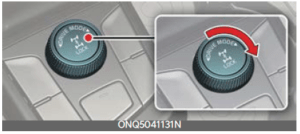
You can switch from DRIVE MODE to SNOW mode by turning the knob. If you turn the DRIVE/SNOW mode button again, the vehicle will go back to DRIVE MODE.
NOTICE
- Even though you turned off the vehicle in SNOW mode, DRIVE mode will be set when you restart the vehicle.
- When the AWD LOCK mode is deactivated, a shock may be felt as the drive power is delivered entirely to the front wheels. This shock is not a mechanical failure.
Brake lock on tight corners
This is a unique characteristic of a 4WD vehicle when making a slow rotation in 4WD Lock Mode. The driver will feel like the brake is applied due to the difference in tire rotation. Steering may be more difficult in a sharp turn on the paved road in 4WD Lock Mode.
WARNING
Do not make fast, sharp turns when 4WD Lock Mode is ON. The steering may be difficult and the accident may happen.
AWD transfer mode selection
| Transfer mode | Selection mode | Description | |
|
DRIVE MODE |
|
• DRIVE MODE is used when driving on roads in normal conditions, roads in urban areas, and on highways.
• All wheels are in operation when a vehicle travels at a constant speed. Required tractions applying on front and rear wheels vary depending on road driving conditions and driving conditions, which will be automatically controlled by the computing system. • When the cluster’s DRIVE MODE display mode is selected, the cluster displays the status of how four wheels’ traction forces are distributed. |
|
|
SNOW |
|
SNOW |
SNOW mode is used to appropriately distribute the vehicle’s traction forces and prevent wheel slippage when driving on snowy or slippery road. |
 |
(Indicator lightis illuminated) |
The main goal of AWD Lock mode is to allow a driver to maximize the vehicle’s traction under extreme driving conditions such as unpaved off- road, sandy roads, and muddy roads. |
|
CAUTION
Normal road conditions
- Maintain DRIVE mode when driving on roads in normal conditions.
- Driving in AWD Lock mode on normal roads may damage the AWD system and cause mechanical vibration or noise.
- When driving under normal road conditions (especially when cornering) in AWD Lock mode, a driver may find minor mechanical vibration or noise, which is an extremely normal phenomenon, not a malfunction. When AWD Lock mode is released, such noise or vibration will be immediately gone.
- When you turn off AWD Lock mode, it can lead to little shocks but this is a normal phenomenon that lasts until the traction forces on the front and rear wheels of the vehicle are released.
WARNING
Brake lock on tight corners
This is a unique characteristic of a AWD vehicle when making a slow rotation in AWD Lock Mode. The driver will feel like the brake is applied due to the difference in tire rotation. Steering may be more difficult in a sharp turn on the paved road in AWD Lock Mode.
Do not make fast, sharp turns when AWD Lock Mode is ON. The steering may be difficult and the accident may happen.
2023 KIA SPORTAGE Specs, Price, Features and Mileage (Brochure)
For safe All Wheel Drive (AWD) operation
NOTICE
All Wheel Drive
The conditions of on-road or off-road that demand All Wheel Drive mean all functions of your vehicle are exposed to extreme stress than under normal road conditions. Slow down and be ready for changes in the composition and traction of the surface under your tires. If you have any doubt about the safety of the conditions you are facing, stop and con-sider the best way to proceed.
- Do not try to drive in deep-standing water or mud since such conditions can stall your engine and clog your exhaust pipes. Do not drive down steep hills since it requires extreme skill to maintain control of the vehicle.
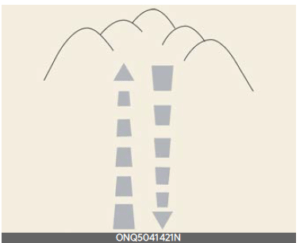
- When you are driving up or down hills drive as straight as possible. Use extreme caution in going up or down steep hills, since you may flip your vehicle over depending on the grade, terrain and water/mud conditions.
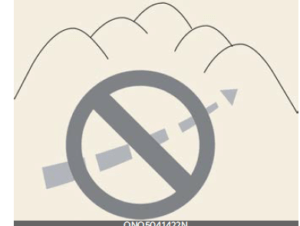
WARNING
Hills
Driving across the contour of steep hills can be extremely dangerous. This danger can come from slight changes in the wheel angle which can destabilize the vehicle or, even if the vehicle is maintaining stability under power, it can lose that stability if the vehicle stops its for-ward motion. Your vehicle may roll over without warning and without time for you to correct a mistake that could cause serious injury or death.
- You must learn how to corner in an AWD vehicle. Do not rely on your experience in conventional FWD vehicles when cornering the vehicle in AWD mode. For starters, you must drive slower in AWD.
WARNING
All Wheel Drive (AWD)
Reduce speed when you turn corners. The center of gravity of AWD vehicles is higher than that of conventional FWD vehicles, making them more likely to roll over when you turn corners too fast.
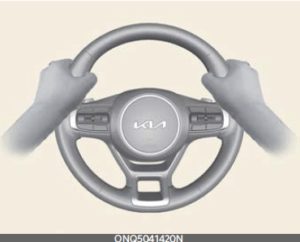
WARNING
Steering wheel
Do not grab the inside of the steering wheel when you are driving on unpaved roads. You may hurt your arm by a sudden steering maneuver or from steering wheel rebound due to impact with objects on the ground. You could lose control of the steering wheel.
- Always hold the steering wheel firmly when you are driving on unpaved roads.
- Make sure all passengers are wearing seat belts.
WARNING
Wind danger
If you are driving in heavy wind, the vehicle’s higher center of gravity decreases your steering control capacity and requires you to drive more slowly.
WARNING
Driving through water
Drive slowly. If you are driving too fast in water, the water can get into the engine compartment and wet the ignition system, causing your vehicle to suddenly stop. If this happens and your vehicle is in a tilted position, your vehicle may roll over.
NOTICE
- Do not drive in water if the level is higher than the bottom of the vehicle.
- Check your brake condition once you are out of mud or water. Press the brake pedal several times as you move slowly until you feel normal braking forces return.
- Shorten your scheduled maintenance interval if you drive in off-road conditions such as sand, mud or water
- Since the driving torque is always applied to the 4 wheels the performance of the AWD vehicle is greatly affected by the condition of the tires.
Be sure to equip the vehicle with four tires of the same size and type. - A full-time All all-wheel drive vehicle cannot be towed by an ordinary tow truck. Make sure that the vehicle is placed on a flat bed truck for moving.
WARNING
All Wheel Drive (AWD) driving
- Avoid high cornering speed.
- Do not make quick steering wheel movements, such as sharp lane changes or fast, sharp turns.
- The risk of rollover is greatly increased if you lose control of your vehicle at high speed.
- In a collision, an unbelted person is significantly more likely to die compared to a person wearing a seat belt.
- Loss of control often occurs if two or more wheels drop off the roadway and the driver over-steers to re-enter the roadway. In the event your vehicle leaves the roadway, do not steer sharply. Instead, slow down before pulling back into the travel lanes.
CAUTION
Mud or snow
If one of the front or rear wheels begins to spin in mud, snow, etc. the vehicle can sometimes be driven out by engaging the accelerator pedal further; however avoid running the engine continuously at high rpm because doing so could damage the AWD system.
Driving in sand or mud
- Maintain slow and constant speed.
Operate the accelerator pedal slowly to ensure safe driving (wheel-slip prevention). - Keep sufficient distance between your
vehicle and the vehicle in front of you. - Reduce vehicle speed and always check the road condition.
- Avoid speeding, rapid acceleration, sudden brake applications, and sharp turns to prevent getting stuck.
- When the vehicle is stuck in snow, sand or mud, the tires may not operate.
- This is to protect the transmission and not a malfunction.
NOTICE
Moving the vehicle forcibly to get out of mud or sand can cause damage/over-heat of the engine or damage/break-down of the transmission, differential or AWD system as well as damage to tires. If excessive wheel slip occurs after entering a sandy/muddy road, the vehicle may fall into the sand/mud. When it happens, put a stone or a tree branch under the tire, and then try to pull out the vehicle, or try to get it unstuck by repeatedly moving forwards and back-wards.
Transmission overheated
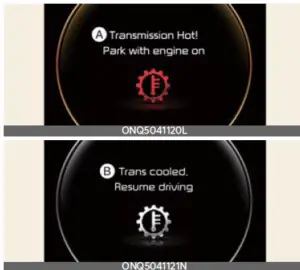
A: Transmission Hot! Park with the engine on
B: Trans-cooled. Resume driving
- When driving on muddy and sandy roads under severe conditions, the transmission could be overheated.
- When the transmission is overheated, the safe protection mode engages and the “Transmission Hot! Park with engine on” warning message will appear on the LCD display with a chime.
- If this occurs, pull over to a safe location, stop the vehicle with the engine running, apply the brakes and shift the vehicle to P (Park), and allow the transmission to cool.
- If you ignore this warning, the driving condition may become worse. You may experience abrupt shifts, frequent shifts, or jerkiness. To return to normal driving conditions, stop the vehicle and apply the foot brake or shift into P (Park). Then allow the transmission to cool for a few minutes with engine on, before driving off.
- When the message “Trans cooled.
Resume driving” appears you can continue to drive your vehicle.
If the warning messages in the LCD display continue to blink, for your safety, have the system checked by an authorized Kia dealer.
Tire precautions
Always pay attention to tires for AWD (all-wheel drive) vehicles.
When driving in all-wheel drive, driving force is applied to all tires, and the driving performance of the vehicle is greatly affected by the degree of tire wear:
- When replacing tires, be sure to equip all four tires with the same size, type, tread, brand and load-carrying capacity. Do not use tire and wheels with different size and type from the one originally installed on your vehicle. It can affect the safety and performance of your vehicle, which could lead to steering failure or rollover causing serious injury.
- Replace the front and rear tire positions every 8,000 miles (13,000 km).
- Each tire should be checked monthly when cold and inflated to the inflation pressure recommended by the vehicle manufacturer on the vehicle placard or tire inflation pressure label.
- For AWD (all-wheel drive) vehicles, install the chains on the front wheels. However, this may damage the AWD system, so keep the travel distance as short as possible.
Towing precautions
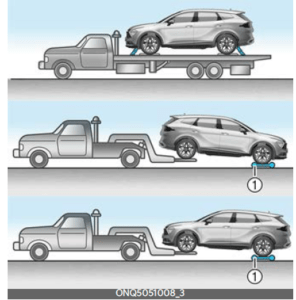
AWD vehicle
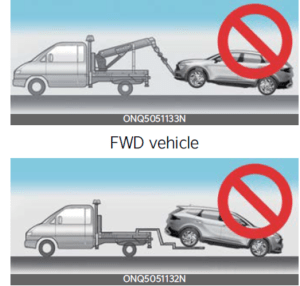
The AWD vehicle should never be towed with the wheels on the ground. Your vehicle must be towed with a wheel lift and dollies or flatbed equipment with all the wheels off the ground.
CAUTION
The AWD vehicle cannot be towed with sling-type equipment. Use wheel lift or flatbed equipment.
WARNING
Your vehicle is equipped with tires designed to provide safe ride and handling capability. Do not use tires and wheels that are different in size and type from the originally installed ones. It can affect the safety and performance of your vehicle, which could lead to steering failure or rollover and serious injury. When replacing the tires, be sure to equip all four tires with the tire and wheel of the same size, type, tread, brand and load-carrying capacity.
WARNING
Jacked vehicle
While the full-time AWD vehicle is being raised on a jack, never start the engine or cause the tires to rotate.
There is the danger that rotating tires touching the ground could cause the vehicle to go off the jack and to jump forward.
- Full-time AWD vehicles must be tested on a special four-wheel chassis dynamometer.
NOTICE
Never engage the parking brake while performing these tests.
- A full-time AWD vehicle should not be tested on a FWD roll tester. If a FWD roll tester must be used, perform the following:
[A]: Roll tester
[B]: Temporary free roller
- Check the tire pressures recommended for your vehicle.
- Place the front wheels on the roll tester (A) for a speedometer test.
- Release the parking brake.
- Place the rear wheels on the temporary free roller (B).
WARNING
Dynamometer testing
Keep away from the front of the vehicle while the vehicle is in gear on the dynamometer. This is very dangerous as the vehicle can jump forward and cause serious injury or death.
CAUTION
- When lifting up the vehicle, do not operate front and rear wheels separately. All four wheels should be operated.
- If you need to operate the front wheel and rear wheel when lifting up the vehicle, you should release the parking brake.
FAQ
What is the automatic transmission (shift lever) in the Kia Sportage 2023?
The automatic transmission in the Kia Sportage 2023 is designed to provide a smooth and efficient driving experience. The shift lever is located on the center console for easy access and features a sequential shift mode for drivers who prefer a more engaging driving experience.
What is the sequential shift mode in the Kia Sportage 2023 automatic transmission?
The sequential shift mode in the Kia Sportage 2023 automatic transmission allows drivers to manually shift gears for a more engaging driving experience.
What is the Sport mode in the Kia Sportage 2023 automatic transmission?
The Sport mode in the Kia Sportage 2023 automatic transmission adjusts the shift points for a more responsive driving experience.
What is the all-wheel-drive (AWD) system in the Kia Sportage 2023?
The all-wheel-drive system in the Kia Sportage 2023 is designed to provide enhanced traction and control in a variety of driving conditions.
How does the AWD system in the Kia Sportage 2023 work?
The AWD system in the Kia Sportage 2023 continuously monitors driving conditions and adjusts torque distribution between the front and rear wheels to optimize traction and handling.
What is the locking center differential in the Kia Sportage 2023 AWD system?
The locking center differential in the Kia Sportage 2023 AWD system can be engaged at low speeds for maximum traction in challenging conditions.
What is torque distribution in the Kia Sportage 2023 AWD system?
Torque distribution in the Kia Sportage 2023 AWD system refers to the amount of power sent to each wheel to optimize traction and handling.
What driving conditions is the Kia Sportage 2023 AWD system designed for?
The Kia Sportage 2023 AWD system is designed for a variety of driving conditions, including wet, snowy, or uneven terrain.
How does the Kia Sportage 2023 AWD system enhance driving performance?
The Kia Sportage 2023 AWD system enhances driving performance by providing improved traction and control, particularly in challenging driving conditions.
What is the benefit of having an AWD system in a vehicle?
The benefit of having an AWD system in a vehicle is that it can improve traction and control in a variety of driving conditions, including wet, snowy, or uneven terrain.
Can the AWD system in the Kia Sportage 2023 be turned off?
Yes, the AWD system in the Kia Sportage 2023 can be turned off if the driver prefers to operate the vehicle in two-wheel drive mode.
How does the automatic transmission contribute to the driving experience in the Kia Sportage 2023?
The automatic transmission in the Kia Sportage 2023 provides a smooth and efficient driving experience, with the sequential shift mode and Sport mode adding to the driving enjoyment.
Is the automatic transmission in the Kia Sportage 2023 reliable?
The automatic transmission in the Kia Sportage 2023 is designed to be reliable and durable.
What is the benefit of having a sequential shift mode in an automatic transmission?
The benefit of having a sequential shift mode in an automatic transmission is that it allows drivers to manually shift gears for a more engaging driving experience.
How does the Sport mode in the Kia Sportage 2023 automatic transmission improve driving performance?
The Sport mode in the Kia Sportage 2023 automatic transmission adjusts the shift points for a more responsive driving experience, which can improve driving performance.
How to put a 2023 Kia Sportage in Neutral?
To put a 2023 Kia Sportage in neutral, press the brake pedal and then use the gear shift lever or electronic selector (depending on the model) to shift the vehicle into neutral (N). Always ensure the vehicle is stationary before changing gears.
Useful Link
View Full User Guide: Kia Sportage 2023 User Guide
Download Manuals: https://owners.kia.com/content/owners/en/manuals.html
2023 KIA SPORTAGE Specs, Price, Features and Mileage (Brochure)

